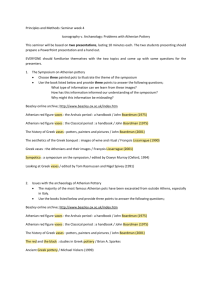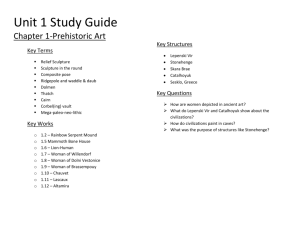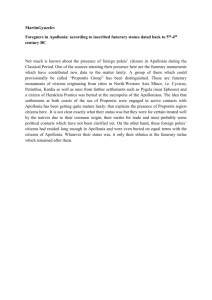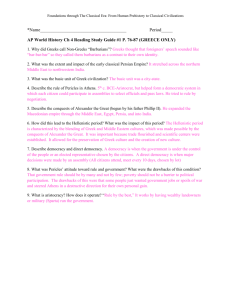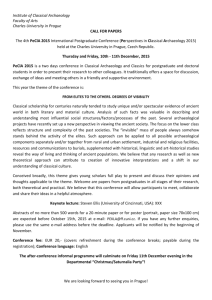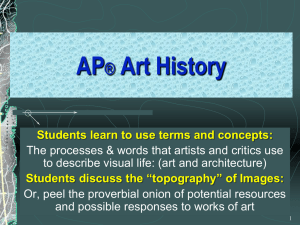Funerary Art in the Classical Period
advertisement
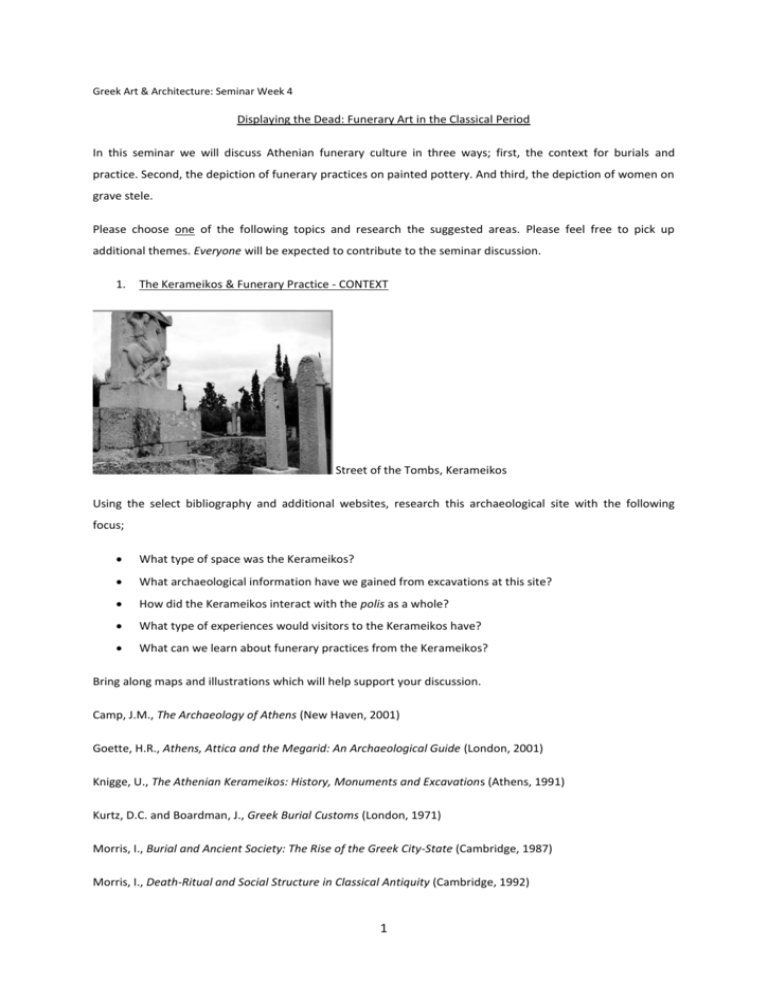
Greek Art & Architecture: Seminar Week 4 Displaying the Dead: Funerary Art in the Classical Period In this seminar we will discuss Athenian funerary culture in three ways; first, the context for burials and practice. Second, the depiction of funerary practices on painted pottery. And third, the depiction of women on grave stele. Please choose one of the following topics and research the suggested areas. Please feel free to pick up additional themes. Everyone will be expected to contribute to the seminar discussion. 1. The Kerameikos & Funerary Practice - CONTEXT Street of the Tombs, Kerameikos Using the select bibliography and additional websites, research this archaeological site with the following focus; What type of space was the Kerameikos? What archaeological information have we gained from excavations at this site? How did the Kerameikos interact with the polis as a whole? What type of experiences would visitors to the Kerameikos have? What can we learn about funerary practices from the Kerameikos? Bring along maps and illustrations which will help support your discussion. Camp, J.M., The Archaeology of Athens (New Haven, 2001) Goette, H.R., Athens, Attica and the Megarid: An Archaeological Guide (London, 2001) Knigge, U., The Athenian Kerameikos: History, Monuments and Excavations (Athens, 1991) Kurtz, D.C. and Boardman, J., Greek Burial Customs (London, 1971) Morris, I., Burial and Ancient Society: The Rise of the Greek City-State (Cambridge, 1987) Morris, I., Death-Ritual and Social Structure in Classical Antiquity (Cambridge, 1992) 1 Patterson, C., ‘Citizen Cemeteries in Classical Athens?’ in Classical Quarterly (2006) 48-56Website: http://www.akropol.net/kerameikos/kerameikos_archaeological_site_map.htm 2. Vase Painting - MATERIAL CULTURE Using the select bibliography and the usual recommended texts, research with the following focus; What type of pottery was specifically associated with Athenian funerary practices and why? Describe the iconography commonly found on this pottery Can we learn anything about Athenian funerary practices from these vases? Using the Beazley Archive database (see website below), describe and interpret the lekythoi illustrated below. Enter the Beazley archive number into the database for more information. a. a. Red-figure white-ground lekythos (Beazley archive no. 1356) b. Red-figure white-ground lekythous (Beazley archive no. 213986) b. 2 Boardman, J., Athenian Red Figure Vases: The Classical Period (London, 1989) Kurtz, D. C., Athenian White lekythoi: Patterns and Painters (Oxford, 1975) Lissarrague, F., Greek Vases: The Athenians and Their Images (U.S, 2001) Website: https://www.beazley.ox.ac.uk 3. Women on Greek Stele - GENDER Using the select bibliography and additional websites, research this topic with the following focus; What was the function of grave stele? How were women depicted on grave stele? Does this depiction of women surprise you? Select at least two examples to discuss with the group. Grave stele of Hegesco, 410-400 B.C, from the Kerameikos Boardman, J., Greek Sculpture: The Classical Period (London, 1985) Lewis, S., The Athenian Woman: An iconographic handbook (London, 2002) Oliver, G.L. (ed.) The Epigraphy of Death: Studies in the History and Society of Greece and Rome (Liverpool, 2000) Reeder, E.L. (ed.) Pandora: Women in Classical Greece (Baltimore, 1995) 3 Stears, K., ‘Dead Women’s Society: Constructing female gender in Classical Athenian funerary sculpture’ in N. Spencer (ed.) Time, Tradition, and Society in Greek Archaeology: Bridging the “Great Divide” (London, 1995) 109-131 Stears, K., ‘Death Becomes Her: Gender and Athenian Ritual’ in S. Blundell and M. Williamson (eds.) The Sacred & the Feminine in Ancient Greece (London, 1998) 113-127 Stears, K., 'The Times They Are A'Changing: Developments in Fifth-Century Funerary Sculpture' in G.L. Oliver (ed.) The Epigraphy of Death: Studies in the History and Society of Greece and Rome (Liverpool, 2000) 25-58 4
